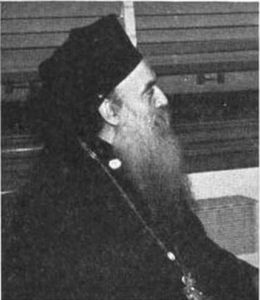Back in the early 1940s, several of the Orthodox jurisdictions briefly came together to form an organization with the unwieldy name, “The Federated Orthodox Greek Catholic Primary Jurisdictions in America.” That’s ridiculous, so we’ll just call it “the Federation.” Anyway, the Federation was a precursor to SCOBA, which morphed into the present-day Assembly of Bishops.
The Federation was active for only a couple years, 1942 to 1944. Its biggest achievement was getting the Orthodox recognized by the Selective Service, which in turn meant that clergy were exempt from the draft and could serve as military chaplains. The Federation was also instrumental in the incorporation of several Orthodox jurisdictions, including the Antiochian Archdiocese, under New York law. (Click here to read a timeline of the Federation.)
What I didn’t know until recently was that the Federation apparently planned to create an English-speaking seminary. I learned this thanks to Lou Milicich, who sent me a link to the December 12, 1943 issue of The Living Church, a publication of the Episcopal Church in America.
The Living Church reported that Archbishop Athenagoras, head of the Greek Archdiocese (and future Ecumenical Patriarch), announced plans for the seminary — but, somewhat oddly, the seminary’s main purpose seems to have been training priests for service in Europe, not the United States. Athenagoras noted that there were already a number of Orthodox seminaries in America, with 155 students between them.
The primary motivation behind this new seminary seems to have been political, more so than pastoral. Here’s what Athenagoras said:
When priests trained at the seminary return to their countries they will help further good will and understanding between the Church in America and the Orthodox Church in Europe. Generally speaking, Americans interested in post-war problems do not realize that the Orthodox Churches in Russia, Greece, Syria, and other countries will have a great influence in rehabilitation efforts after the war. Our purpose is not only to train future priests in democratic precepts, but to convince them that real democracy consists of much more than mere lip service.
It’s easy to see why Athenagoras was the U.S. government’s first choice for the position of Ecumenical Patriarch after World War II, just as the Cold War was getting started. He was a church politician who was ardently pro-American (and anti-Communist).
Archbishop Athenagoras announced plans for other initiatives, including “a central bureau of publicity for Orthodox affairs” and a pan-Orthodox English-language magazine. And also this (reported by The Living Church):
Arrangements have already been made for a census of all Orthodox Churches in the United States, which will provide up-to-date statistics on the number of priests, communicants, churches, and schools in each of the jurisdictions. There are at present, the Archbishop estimated, over 5,000,000 Orthodox believers in this country, served by 25 bishops and 1,500 priests.
This was over 65 years before Alexei Krindatch came on the scene, and more than 75 years before the first really comprehensive census of Orthodox parishes, in 2010. Unfortunately, the proposed census in the 1940s didn’t happen, because the Federation unraveled shortly after this article was published. There was some sort of population data published in 1947, in a periodical called the Christian Herald. (For more on that census, and previous Orthodox censuses, click here.)
As I said, the Federation didn’t last very long, failing mostly due to leadership issues. (One of the driving forces behind the Federation was a Greek lawyer named George Phillies, who for some reason took communion both in the Orthodox Church and the Episcopal Church. Once that got out, the Federation quickly fell apart.) That said, the idea of the Federation did live on, and thanks in part to the efforts of the Antiochian Metropolitan Antony Bashir (click here for more on that), from the ashes of the Federation arose SCOBA, which, for all its faults, served as a critical platform for pan-Orthodox cooperation for many decades.

Uh, I’m afraid you are re-writing history. The first American Theological Seminary was established in Minneapolis, 1905 – 1912. Services were in English. Later, moved to Tenafly, NJ in 1912 and later to NYC. Later, in 1938, a graduate school of Orthodox theological education, based on the European model of an academy, was formed called St. Vladimir’s Seminary in NYC. Also, a pastoral school was established at St. Tikhon’s Monastery/Seminary.
How am I re-writing history? I didn’t say this would have been the first seminary in America, or anything like that.
Your writing gives one the impression that nothing regarding an English speaking seminary existed in the U.S. before 1942 and that the Greeks instituted such an endeavor. The Greeks were late comers!
If you read the article itself, it doesn’t say that. The impression isn’t being “given” by the piece. It’s being assumed.